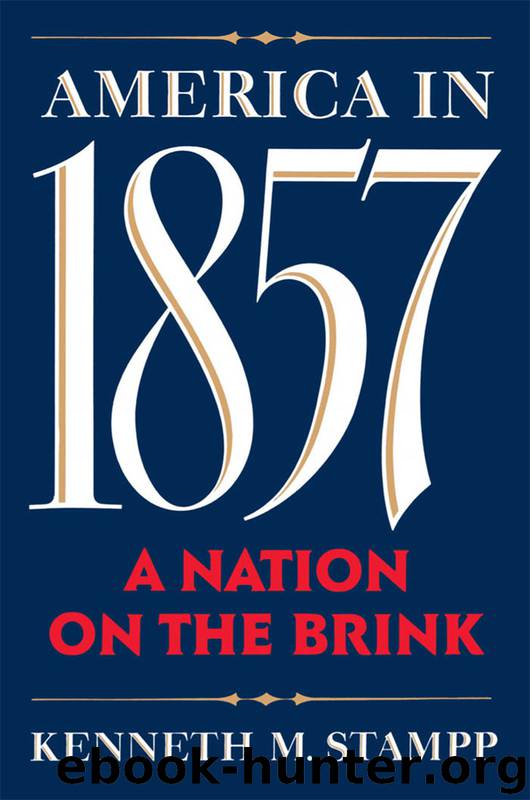America In 1857 by Stampp Kenneth M.;

Author:Stampp, Kenneth M.;
Language: eng
Format: epub
Publisher: Oxford University Press, Incorporated
Published: 1992-03-20T16:00:00+00:00
In mock sympathy for Buchanan and his problem with filibusters, the New York Times suggested that he appoint William Walker governor of Utah Territory. Then let him take his brave followers to Salt Lake City, plant a settlement of “gentiles,” and challenge the power of Brigham Young and his dedicated Mormon followers.34 During the summer of 1857 Young and the members of his Church of Jesus Christ of Latter-day Saints were more often the source of public vexation than public levity. Like the recent Catholic immigrants, they were severely testing the strength of the American commitment to the constitutional guarantee of religious freedom. Moreover, having developed patterns of community organization and family life that were both different and unpopular, they had isolated themselves culturally from other Americans. In Utah they had, in effect, applied the principle of territorial popular sovereignty—the right “to form and regulate their domestic institutions in their own way”—rather differently than Douglas had intended.
After some early hardships the Mormons had enjoyed ten years of peace and prosperous growth in the Great Salt Lake basin, and their missionaries had brought in thousands of converts from the East and from Europe. Yet their past experiences with hostile neighbors, persecutions, and flight were still too recent to be forgotten. The church had been founded in 1830 in upstate New York soon after Joseph Smith had incorporated in the Book of Mormon miraculous revelations he claimed to have received from God. In his search for a new Zion, Smith had taken his followers from New York to Kirtland, Ohio, then to several locations in Missouri, then to a town site in Illinois which he named Nauvoo.
Everywhere they settled the Saints had irritated the “gentiles” who lived nearby, in part because of their close-knit communitarian social organization, in part because they prospered, and in part because of their conviction that Mormonism, being the only true faith, made them a “chosen people” and gave Joseph Smith, their prophet, the power to communicate directly with God. In Hiram, Ohio, Smith was seized by a mob and tarred and feathered. In Missouri, after fleeing from one community to another, some of the more militant Mormons formed the secret Danite Band and engaged in violent conflict with the “gentiles.” In 1839, following the massacre of seventeen Mormons at Haun’s Mill, the arrest and imprisonment of Smith and other church leaders, and the destruction of their community at Far West, the Saints left Missouri, carrying with them particularly bitter memories.
In Nauvoo they flourished economically and their membership grew to more than thirty thousand. Soon their Illinois neighbors turned as hostile to them as the Missourians. It was there, in the early 1840s, following another alleged revelation, that Joseph Smith and a few dozen other leaders of the church secretly adopted the practice of “plural marriage.” The practice briefly caused a crisis within the church itself, and, in spite of Smith’s public denials, sensational reports of Mormon polygamy began to circulate among the “gentiles.” A few years later the Nauvoo phase of Mormon history came to an end.
Download
This site does not store any files on its server. We only index and link to content provided by other sites. Please contact the content providers to delete copyright contents if any and email us, we'll remove relevant links or contents immediately.
| Books & Reading | Comparative Literature |
| Criticism & Theory | Genres & Styles |
| Movements & Periods | Reference |
| Regional & Cultural | Women Authors |
4 3 2 1: A Novel by Paul Auster(11950)
The handmaid's tale by Margaret Atwood(7537)
Giovanni's Room by James Baldwin(6922)
Asking the Right Questions: A Guide to Critical Thinking by M. Neil Browne & Stuart M. Keeley(5457)
Big Magic: Creative Living Beyond Fear by Elizabeth Gilbert(5443)
Ego Is the Enemy by Ryan Holiday(5066)
On Writing A Memoir of the Craft by Stephen King(4725)
The Body: A Guide for Occupants by Bill Bryson(4694)
Ken Follett - World without end by Ken Follett(4508)
Adulting by Kelly Williams Brown(4333)
Bluets by Maggie Nelson(4331)
Eat That Frog! by Brian Tracy(4246)
Guilty Pleasures by Laurell K Hamilton(4179)
The Poetry of Pablo Neruda by Pablo Neruda(3884)
White Noise - A Novel by Don DeLillo(3863)
Alive: The Story of the Andes Survivors by Piers Paul Read(3803)
Fingerprints of the Gods by Graham Hancock(3797)
The Book of Joy by Dalai Lama(3761)
The Bookshop by Penelope Fitzgerald(3656)
